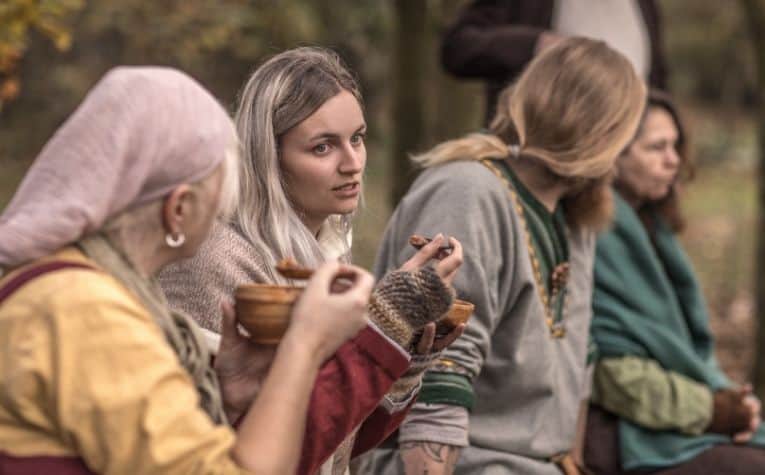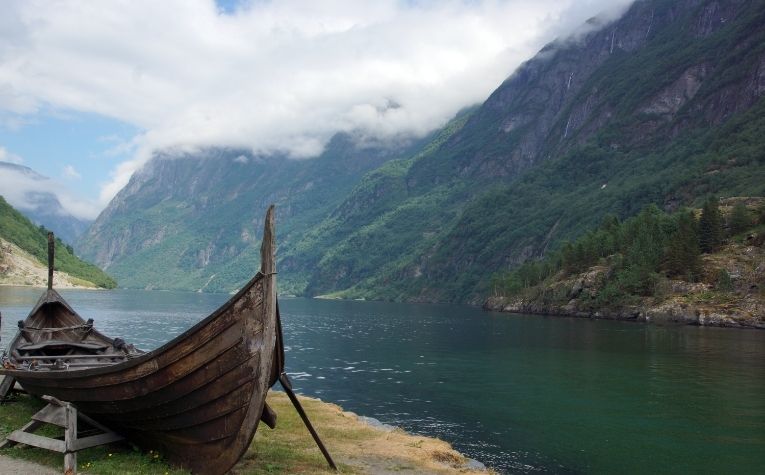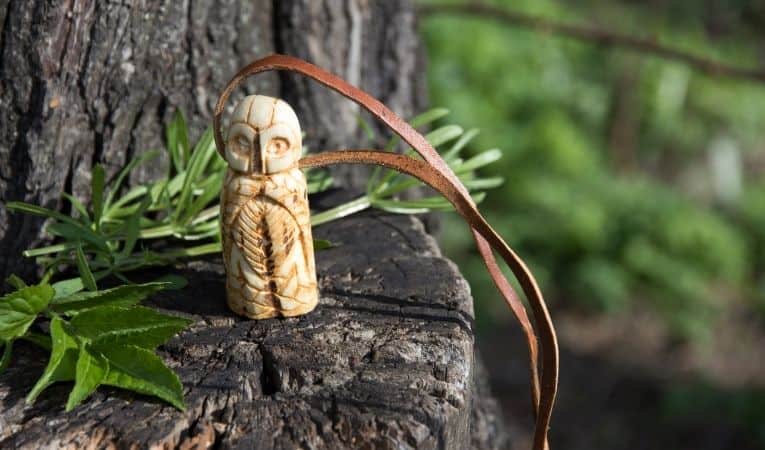The concept of clans has existed throughout history. It has allowed like-minded people to join together in numbers for prosperity and security.
In Europe, being part of a clan meant either claiming ancestry belonging to a specific family, being a landowner or tied to the land in a particular region, or pledging allegiance to a local magnate or chieftain.
In the case of the Vikings, they evolved from a primarily clan-based society to one that was controlled by a centralized government in the form of kingdoms ruled by kings.
Through it all, there were three distinct classes of Vikings: the wealthy and powerful, the ordinary citizens, and the slaves.
While the Vikings are probably best known for their raids and the brutal efficiency with which they executed them, back in their homelands, the Norse people favored structure and order within their society.

Ironically, the lawlessness and chaos that characterized their ruthless plundering and pillaging of towns and villages throughout Northern Europe were not tolerated on their native soil.
The Vikings dominated Scandinavia for a time, but what was it like before that? See Scandinavia Before the Vikings to learn more.
The Transition from Clans to Kingdoms
During the early stages of the Viking Age, much of Scandinavia (Norway, Sweden, and Denmark) was a loose and sometimes unstable patchwork of local clans overseen by magnates, or as they were more commonly referred to, chieftains.
A Viking chieftain was an influential leader on a sometimes regional, but most typically small, local level. In other words, a chieftain was a big fish in a small pond.
Viking chieftains rose to power by their military accomplishments, their wealth (as measured primarily by land, property, or treasure, as the Vikings at that time did not have a monetary currency), their ancestry, or a combination of these factors. (Also see 10 Famous Vikings from History)

They were only as strong and powerful as their base of support, which was usually comprised of free men not quite as prominent as the chieftain but still influential in their own right, as well as ordinary, working-class citizens.
Throughout Scandinavia, chieftains not only had to maintain their position within their clan, but they also had to be vigilant against neighboring or rival magnates seeking to expand theirs.
Eventually, Norway, Denmark, and Sweden transitioned from unorganized clan-based societies to kingdoms unified under all-powerful rulers who were essentially the royal class. [1]
This occurred at different points during the Viking Age:
- In Norway, kings rose to power in the 9th century.
- In Denmark, it happened during the 10th century.
- In Sweden, a royal class rose in the 12th century.
Did the Vikings just vanish from history? See What Happened to the Vikings? to learn more.
The Three Classes of Viking Society
Other than Viking royalty, there were three classes of people that comprised Norse society:
- The aristocracy, or upper class, which were known as the Jarls
- The working class, who had full freedom and protection under Norse law, known as the Karls
- The lowest class, who were slaves with no recognized rights, who were known as the Thralls [2]
A famous Norse poem in the Poetic Edda collection recites how these three classes came to be and how they were named. (Also see What Did the Vikings Eat?)
The Norse Poem Rigsthula
The Vikings viewed the Norse god Heimdall as their protector, and the poem Rigsthula tells the tale of how the three classes of Viking society came to be through the exploits of Heimdall while in the human realm of Midgard.
As the story goes, Heimdall visited Midgard disguised as a traveling king named Rig.
During these travels, he made stops at three homes, spending three nights in each, telling tales and sharing bits of wisdom with the inhabitants, and laying in each bed with the wife of the household.
The Vikings were religious people. See Were the Vikings Christians? The Facts to learn more.
Each of these encounters produced an offspring:
- The poor wife bore an ugly, brutish son with “knotted hands” who was named Thrall.
- The farmer’s wife bore a son named Karl, who was strong with an earnest character.
- With the well-to-do wife, Rig produced a son named Jarl, and he was a handsome blonde boy who exhibited a thirst for knowledge and adventure and an affinity for fighting.
Jarl subsequently had a son named Kon, who caught the eye of Rig/Heimdall.
The god took Kon under his wing and began to teach him to read and write in the old runes, grooming him for a future leadership role.
Thus, not only were the Norse aristocrats looked favorably upon by the gods themselves, but all the classes existed as ordained by the highest of mythological authorities. [3]

The Jarls – Viking Upper Class
The Viking aristocracy was comprised primarily of chieftains and magnates, a class of a relative few who, aside from the kings, held the majority of the wealth.
The English word “earl” was derived from Jarl, and the first Norse kings rose from the ranks of this upper class.
The Jarls, who were essentially warlords, depended on the support of a closely-knit base of loyal warriors and citizens to maintain dominion over their clan and territory.
These forces would also serve as a deterrence against neighboring Jarls who had designs on gaining more power or influence.
They would also accompany the chieftain on raids and trade expeditions.
While outwardly fierce and forged through conflict, this loyalty was bought by the Jarls in the form of gifts of gold and silver, prized items like swords and shields, and lavish feasts with fine food and even finer ale.
During famine or hardship, the Jarls would open up their private stockpiles of food and supplies to keep their citizens from seeking aid (and pledging their allegiance) elsewhere.
At the heart of the relationship between a Jarl and his loyal followers was a willingness to battle together and die an honorable death on the battlefield if such was the will of Odin and his Valkyries.
So while Jarls certainly filled their cohorts’ material wants and needs, they also appealed to their innate sense of pride and honor to fight for their clan leader and gain admission to Valhalla. [4]
The Karls – Viking Working Class
The middle tier of Viking society’s class structure was by far its largest.
The overwhelming majority of Vikings were Karls.
Even though all Karls shared the same freedoms and protections under Norse law, there was a considerable disparity within this class regarding wealth, status, and power.
The typical Karl was a farmer, merchant, skilled laborer, or artisan.
Some may have owned modest parcels of land on which to farm and raise livestock, while others rented land from wealthier members of their community.
Although not common, it would have been possible for certain Karls with means and some influence to elevate themselves to the status of Jarls, but most Karls remained Karls for life.
It was necessary, socially and economically, for Karls to pledge their allegiance to a Jarl and demonstrate their loyalty through a willingness to take up arms on the Jarl’s behalf.
Such support would be rewarded with gifts and provisions. [5]
The Thralls – Viking Slaves
The lowest of the classes in Viking society was the Thralls, who were slaves that performed manual labor and household chores for their Jarl or royal class owners.
Sadly, slave trading was a highly lucrative industry during the Middle Ages and the Vikings, like other European cultures, took full advantage of the economics of the times.
While most Viking slaves were prisoners of war and people taken from their homes in areas raided and plundered by Viking warriors, some Thralls were of Scandinavian descent.
Male Thralls would typically work in the fields performing back-breaking farm work or dirty jobs like feeding and cleaning livestock. Female slaves were usually given tasks like cleaning, cooking, and making clothes.
Slaves who their owners gave the opportunity to earn compensation on the side by making and selling crafts could conceivably buy their freedom by repaying their purchase price.
Some slave owners rewarded their Thralls with freedom after years of loyal service.
But the reality for most Thralls was that they would die slaves, and so would their children. [6]
Conclusion
During the Viking Age, the structure of Norse society was such that people were born into their stations in life with little hope of escaping them.
References:
[1] https://www.canadianmysteries.ca/sites/vinland/vikinglife/society/indexen.html
[2] https://www.ancient.eu/Vikings/
[3] https://mythopedia.com/norse-mythology/gods/heimdall/
[4] https://norse-mythology.org/viking-political-institutions/
[5] https://www.medievalchronicles.com/medieval-history/medieval-history-periods/vikings/viking-people/
